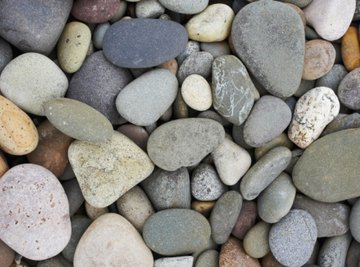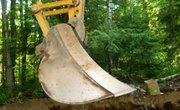
Gravel consists of particles of rock and other materials that are between 3/16 of an inch and 3 inches in diameter. The edges of these pieces might be smooth or sharp. Gravel is often used in landscaping along walkways, garden paths and on roadways and driveways. There are several types of gravel that are typically separated into two main categories.
Man-Made Gravel
Man-made gravel consists of stones that are mechanically crushed and filtered. The term refers to the way in which it is processed. Typically, man-made gravel has sharp edges and is used for driveways, walkways and roads. Granite, the most commonly used type of man-made gravel, is gray with white specks or swirls. Larger granite stones are used for driveways and drainage systems and smaller stones are used for stone beds or decorative pathways. Slate gravel is typically crushed to small stones and is dark gray in color. Crimson stone gravel consists of reddish-purple stones that are used in pathways around gardens. Crushed stone gravel refers specifically to limestone or dolemite that is mechanically crushed. The stones in this type of gravel have sharp edges, and it is commonly used in concrete production. Coarse gravel that accumulates after finer particles are filtered out for specific uses is called lag gravel.
Naturally-Formed Gravel
Naturally-formed gravel is gathered and shaped by natural sources such as rivers. This type of gravel is usually smooth and round or oval-shaped. Naturally-formed gravel is commonly used in landscaping, where it must be smooth because it comes in contact with bare hands and feet. The most commonly used naturally-formed gravel is pea gravel. This gravel is a small, round and usually beige or gray in color. Lava rock is a lightweight gravel that is reddish brown with very sharp edges. Quartzite is also naturally-formed and similar in texture and size to pea gravel but brighter in color. Quartzite is often mixed with other gravels and is used for driveways, pathways and in drainage applications. Naturally-formed gravel originating from streams that remains on the side of a valley after the water level recedes is called bench gravel. Plateau gravel is formed the same way, but is found on a plateau. Stones which originate in high areas and are carried by mountain streams down to flat areas is called piedmont gravel.
Bank Gravel
Naturally-formed gravel of any type that is mixed with sand or clay is called bank gravel. Bank gravel has large stones mixed with dirt and smaller stones. It is used to fill low spots in yards and for building up areas where concrete will be placed, such as in driveways.
Pay Dirt Gravel
Pay dirt gravel is naturally-formed gravel that is extracted when panning for gold. This type of gravel contains precious metals such as silver and gold but may be comprised of a variety of rock material.
About the Author
Renee Miller began writing professionally in 2008, contributing to websites and the "Community Press" newspaper. She is co-founder of On Fiction Writing, a website for writers. Miller holds a diploma in social services from Clarke College in Belleville, Ontario.
Photo Credits
Jupiterimages/Photos.com/Getty Images
